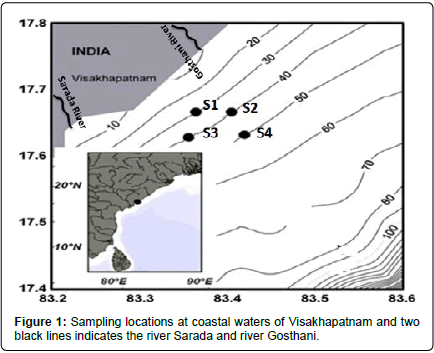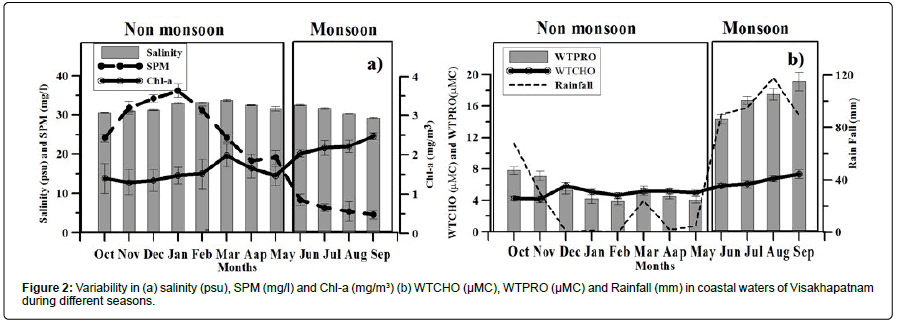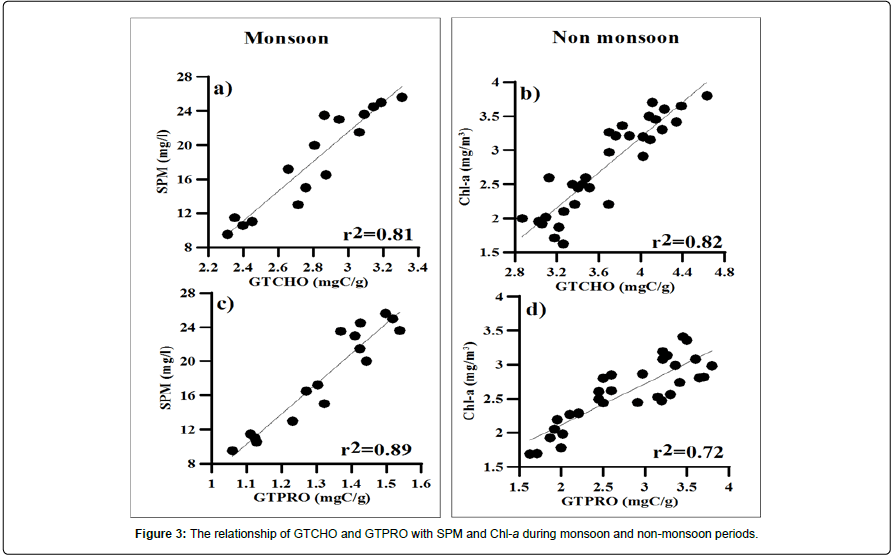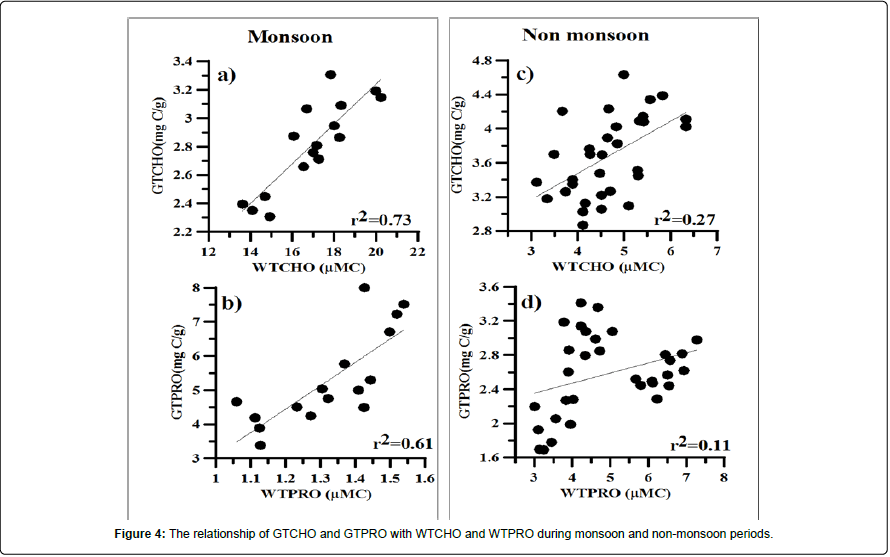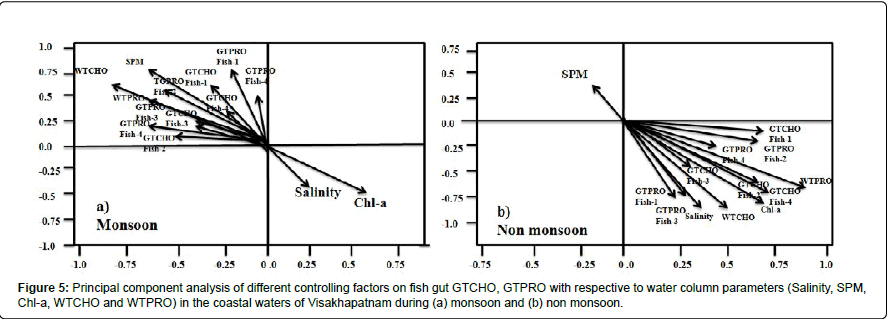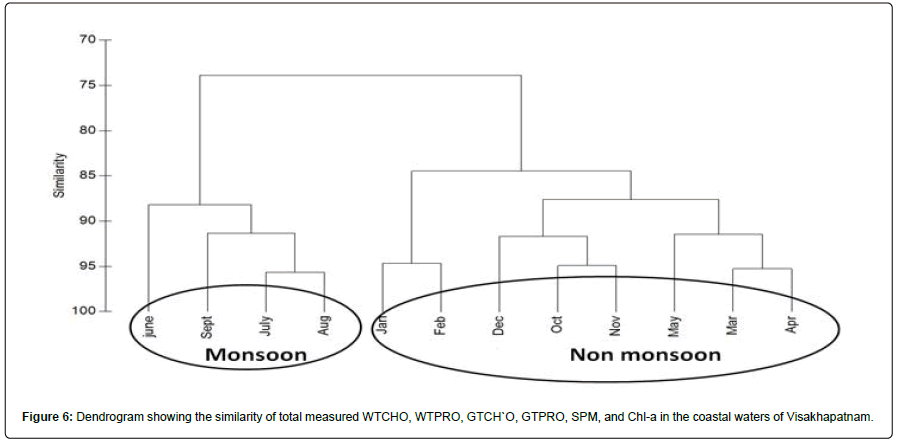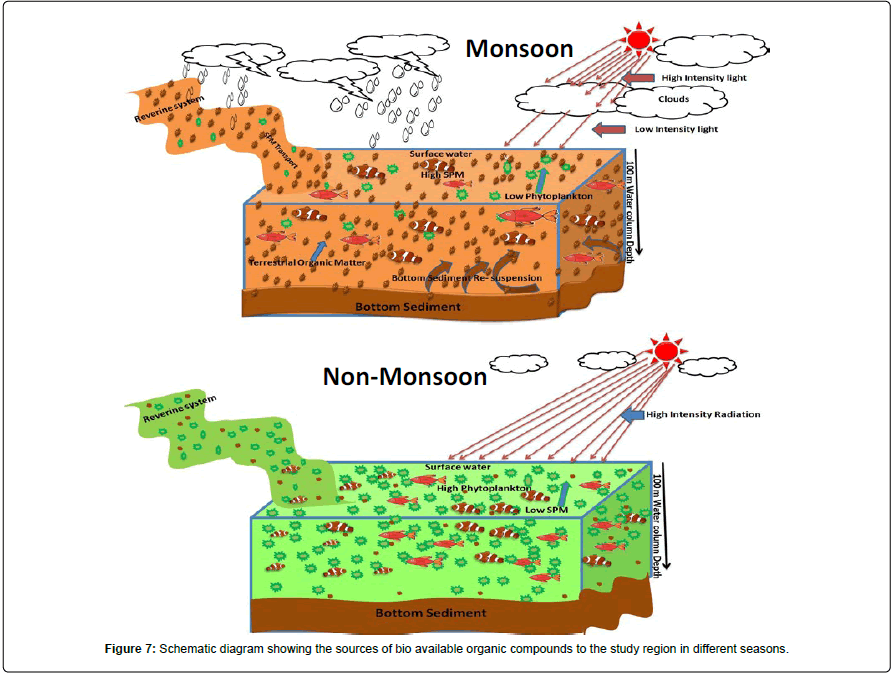Research Article, J Mar Biol Oceanogr Vol: 9 Issue: 2
Food Sources of Bioavailable Organic Compounds (Carbohydrates , Proteins) to Four Different Types of Fishes in Coastal Waters of Visakhapatnam, East Coast of India
BSK Kumar1*, DB Rao1, MN Krishna2 and M Rallabhandi1
1Department of Physical, Nuclear and Chemical Oceanography, Andhra University, Visakhapatnam, Andhra Pradesh, India
2Department of Marine Living Resource, Andhra University, Visakhapatnam, Andhra Pradesh, India
*Corresponding Author : BSK Kumar
Department of Physical, Nuclear and
Chemical Oceanography, Andhra University, Visakhapatnam, Andhra Pradesh,
India
E-mail: sivakirankumar.busala@gmail.com
Received: April 23, 2020 Accepted: May 10, 2020 Published: May 16, 2020
Citation: Kumar BSK, Rao DB, Krishna MN, Rallabhandi M (2020) Food Sources of Bioavailable Organic Compounds (Carbohydrates, Proteins) to Four Different Types of Fishes in Coastal Waters of Visakhapatnam, East Coast of India. J Mar Biol Oceanogr 9:2.
Abstract
The present study was carried out to understand the possible sources of bio available organic compounds and food sources to the four different fishes at Visakhapatnam coastal waters during monsoon and non-monsoon seasons. This study revealed that presence of high suspended matter (25.2 ± 2 mg/l) and low phytoplankton biomass (Chl-a; 0.6 ± 0.2 mg/m3) during monsoon season and low suspended matter (15.1 ± 1 mg/l) and high Chl-a (2.7 ± 0.6 mg/m3) during non-monsoon season in water column. Total protein (WTPRO) to total carbohydrate (WTCHO) ratios in water column suggesting that presence of freshly produced organic matter during non-monsoon season and terrestrial or modified organic matter during the monsoon season. In addition to this total protein (GTPRO) to total carbohydrate (GTCHO) ratios in four fish guts also showing <1 during monsoon and >1 during non-monsoon seasons suggesting that the major food source during monsoon is terrestrial originated organic matter and during non-monsoon in situ produced organic matter.
Keywords: Carbohydrates; Proteins; Visakhapatnam; Fish; Protein to carbohydrate ratio
Introduction
Fishes are one of the different food sources from the other because they provide calories with high-quality proteins, which contain all essential amino acids in an easily digestible form, so they are beneficial nutrition source [1]. In terms of nutrition, fish is considered as a rich source of protein and contains good quality fat, and micronutrients [2]. Generally, changes in chemical composition of the body have been known to reflect storage or depletion of energy reserves. The bio chemical composition of fishes’ body varies considerably within and between species, with fish size, sexual condition, feeding, season and activity, in addition to this, food composition, environment and genetic trait are also known to influence chemical composition of fish [3,4]. Biochemical compound studies in fish are quite interesting because of their specificity in relation to the food values of the fish and for the evaluation of their physiological needs at different periods of life. It is also necessary to have the data on the composition of fish in order to make the best use of it as food and also to develop the technology of fish processing and fish products.
Health benefits of fish meat have been studied extensively and there are reports which confirm its preventive effects against cardiovascular diseases and some types of cancer, including colon, breast and prostate cancer [5-7]. These effects are largely attributable to the Polyunsaturated Fatty Acids (PUFA) found in fish oils especially the n-3 family including the Eicosapentaenoic Acid (EPA or 20:5 n-3), the Docosapentaenoic Acid (DPA or 22:5 n-3) and the Docosahexaenoic Acid (DHA or 22:6 n-3) which are not synthesized in the human body but their inclusion in human diets is essential [8]. It is also reported that n-3 PUFA has been recognized as an important component with beneficial properties for the improvement of visual function [9] and also for the prevention of atherosclerosis and thrombosis [10]. Although PUFA composition may vary among different fish species of both freshwater and marine origins [11], it is important for human health, to increase the consumption of fish and its products [12]. Kim and Mendis, [13] noticed that bioactive peptides isolated from various fish protein hydrolysates know to exhibit antithrombotic, antihypertensive, ant oxidative and immunomodulatory activities. Biochemical composition (carbohydrates, proteins, lipids, amino acids, and fat) of different fishes in different seasons are also well reported [14-17]. There are very few literatures on the sources of a biochemical compound to fish in the aquatic system. The main aim of this study is to understand the variability in the biochemical composition in four fish species with respective to water column properties and the sources of food to the fish during different seasons.
Materials and Methods
Surface coastal water (<50 m water column depth away from the coast considered as coastal waters) samples were collected in the Bay of Bengal at four fixed stations (S1, S2, S3, and S4) (Figure 1) at monthly intervals from Oct-2015 to Sept-2016. Water column temperature and salinity were measured using a portable Conductivity-Temperature- Depth profiler (CTD; SBE-19 plus, Sea-Bird Electronics, USA). Surface water samples were collected using 5 L Niskin bottles. Extreme care was taken to avoid contamination of organic carbon samples during sub sampling from Niskin bottle and sub sample for total carbohydrates in water (WTCHO) and total proteins in water (WTPRO) were collected in acid clean 60 ml glass bottles and they were closed with glass stoppers and frozen at -10°C until analysis. 500 ml to 1000 ml water sample was filtered through 0.7 μm GF/F filter (Whatman) and phytoplankton biomass retained on filter was extracted with N, N-dimethylformamide, at 4°C in dark for 12 h, and the fluorescence in the extract was measured using spectrofluorophotometer (Varian Eclipse spectrofluorometer, USA) following Suzuki and Ishimaru [18]. The analytical precision for Chl-a analysis was ± 4%. Suspended Particulate Matter (SPM) was measured based on weight difference of the matter retained on 0.22 μ pore size polycarbonate filter before and after filtration of surface sea water.
Four Fishes (Fish-1: Rastrelliger kanagurta, Fish-2: Sardinella longiceps, Fish-3: Sadinella gibbosa and Fish-4: Sardinella albella) were collected in fresh condition monthly from fishing boats operating from the north-east coast of Visakhapatnam, Andhra Pradesh, India, during the period Oct-2016 to Sept-2017. The collected fishes were kept in the ice box and transferred to the laboratory. They were thoroughly cleaned under the running tap water; excess water was removed with blotting paper. The specimens were dissected immediately to avoid decomposition. Muscle tissue and gut was removed and their weights were taken immediately. For the analysis, muscle tissues were taken just below the dorsal and above the lateral line is used and gut part of the fish. The tissues and guts were kept in hot air oven at 60°C for about a week to dry the material. After drying the tissues and guts samples were pulverized and ground into a fine powder with the help of a porcelain mortar. The powder was preserved in desiccators for later use. Individually weighed powder samples were used for the quantitative estimation of total carbohydrates in mussels (MTCHO) and total mussel proteins (MTPRO), and total carbohydrates in the gut (GTCHO) and total proteins in gut (GTPRO). The moisture content was determined using the oven drying method described in Association of Official Analytical Chemists [19]. Total amount of carbohydrates was analyzed by following the method Dubois [20] using Shimadzu UV-1800 Spectrophotometer. Total amount of proteins was analyzed following the method of Lowry [21] using a Shimadzu UV-1800 Spectrophotometer. Samples were analysed in duplicate and reported as mean values of duplicate samples. Precision for total carbohydrates, total proteins were ± 0.11, ± 0.2 micro mole (μM) respectively.
Graphical representation and statistical analyses of data
The software ‘‘Grapher’’ was used for graphical representation of X-Y plots (2 Dimensional) of our data and for statistical analysis, the Rank Correlation matrix (Spearman's; r2), and student t-test, PRIMER was used for drawing dendrogram and SPSS was used for Principal component analysis.
Results
Hydrographic parameters, Salinity, SPM and Chl-a at Visakhapatnam coastal waters
Indian subcontinent experiences two kinds of monsoons (summer and winter), south west (SW; summer) and north east (NE; winter), in generally SW monsoon occurs during Jun to Sept and NE during Nov to Feb, but India has more rain fall during SW than NE monsoon. In present study region maximum rain fall was 98 ± 14 mm during SW monsoon and during other season (16 ± 12 mm; Table 1). The quantity of precipitation is one of the indicators of having low saline, high turbid waters at coastal regions. Surface salinity ranged from 29.5 psu to 32.5 psu over the study period (Table 1 and Figure 2a) and it was lower during the monsoon season (30.5 ± 0.9 psu; Table 1) than the non-monsoon season (32.0 ± 1.0 psu; Table 1). SPM was found to be high during the monsoon season (25.2 ± 2 mg/l, Table 1 and Figure 2a) than non-monsoon (15.1 ± 1 mg/l; Table 1 and Figure 2a). Phytoplankton biomass in terms of Chlorophyll-a (Chl-a) varied from 0.4 mg/m3 to 3.7 mg/m3 (Figure 2a) and found higher concentrations during the non-monsoon season (2.7 ± 0.6 mg/m3) than monsoon season (0.6 ± 0.2 mg/m3; Table 1). Total carbohydrates in surface water (WTCHO) ranged from 3.1 μMC to 20.2 μMC and high concentrations were found during the monsoon season (16.9 ± 1.9 μMC; Table 1) than non-monsoon (4.6 ± 0.8 μMC; Table 1 and Figure 2b), and total proteins in surface water (WTPRO) varied from 3.2 μMC to 8.4 8 μMC and followed the same pattern of WTCHO (Table 1) showing that high concentrations during monsoon (5.3 ± 1.4 μMC) than non-monsoon season (4.8 ± 1.3 μMC).
| Season | Rain fall (mm) | Salinity (psu) | SPM (mg/l) | Chl-a (mg/m3) | WTCHO (µMC) | WTPRO (µMC) | WTPRO: WTCHO |
|---|---|---|---|---|---|---|---|
| Monsoon | 98 ± 14 | 30.5 ± 0.9 | 25.2 ± 2 | 0.6 ± 0.2 | 16.9 ± 1.9 | 5.3 ± 1.4 | 0.4 ± 0.2 |
| Non monsoon | 16 ± 12 | 32 ± 1.0 | 15.1 ± 1 | 2.7 ± 0.6 | 4.6 ± 0.8 | 4.8 ± 1.3 | 1.4 ± 0.5 |
Table 1: Mean concentrations (± SD) of Rain fall (mm), salinity (psu), SPM (mg/l), Chl-a (mg/m3), WTCHO (μMC), WTPRO (μMC) and WTPRO: WTCHO in Visakhapatnam coastal water, during monsoon and non-monsoon periods with sample number 32 and 64 respectively.
Intra annual variability in the physical and biochemical composition of fish
Variability in moisture content: Moisture was found to be the major component of the proximate composition and our results showed that highest moisture content during the non-monsoon season than monsoon season. Highest moisture was observed in the fish-3 (76.5 ± 1.2%) and fish-4 (76.3 ± 0.58%) followed by fish-2 (74.3 ± 1.1%) and fish-1(73.1 ± 0.8%) (Table 2).
| Moisture (%) | MTCHO (mg C/g) | t-test | MTPRO (mg C/g) | t-test | ||||
|---|---|---|---|---|---|---|---|---|
| Monsoon | Non monsoon | Monsoon | Non monsoon | Monsoon | Non monsoon | |||
| Fish-1 | 69.3 ± 0.5 | 73.1 ± 0.8 | 5.2 ± 0.8 | 4.9 ± 2.2 | 0.92* | 25.2 ± 2.1 | 20.4 ± 0.2 | 2.12** |
| Fish-2 | 70.8 ± 2.5 | 74.3 ± 1.1 | 6.6 ± 1.1 | 3.6 ± 2.5 | 2.56*** | 28.6 ± 1.2 | 22.1 ± 0.5 | 2.89*** |
| Fish-3 | 73.5 ± 1.1 | 76.5 ± 2.2 | 5.13 ± 0.9 | 4.2 ± 0.9 | 1.85** | 25.1 ± 0.9 | 21.6 ± 1.1 | 1.95** |
| Fish-4 | 74.2 ± 0.8 | 76.3 ± 0.32 | 4.2 ± 1.1 | 3.1 ± 0.7 | 1.19** | 26.2 ± 0.8 | 20.8 ± 1.5 | 2.98*** |
*p<0.01, **p<0.05, ***p<0.001 respectively
Table 2: Mean concentrations (± SD) of Moisture (%), MTCHO (mg C/g) and MTPRO (mg C/g) in four different fishes at Visakhapatnam coastal water during monsoon and non-monsoon periods.
Total carbohydrates and total proteins in fish mussel: MTCHO (Total mussel carbohydrate) content in the present study in fish mussel varied from 2.7 mg C/g to 4.9 mg C/g and in monsoon highest concentration was found in fish-2 followed by fish-3, fish-1and fish-4. During non-monsoon season, the highest concentration was found in fish-1, followed by fish-3, fish-2, and fish-4 (Table 2). It clearly indicates that MTCHO concentrations are higher in monsoon season than non-monsoon (Table 2). MTPRO was found in the range of 15.6 mg C/g to 29.6 mg C/g in all four fishes and found to be high during monsoon than non-monsoon (Table 2). The highest MTPRO was found in fish-2 followed by fish-4, fish-1 and fsh-3 during monsoon season.
Total carbohydrates and total proteins in fish gut: GTCHO varied from 1.2 mg C/g to 6.1 mg C/g and the highest mean concentration was found during monsoon (3.8 ± 0.8 mg C/g) than non-monsoon (2.5 ± 0.5 mg C/g). During monsoon highest concentration was found in fish-2, followed by fish-3, fish-1, and fish-4 and during nonmonsoon highest GTCHO noticed in fish-2, followed by fish-3, fish-4, and fish-1. GTPRO varied from 1.1 mg C/g to 3.4 mg C/g and the highest concentrations was found during non-monsoon season than monsoon (Table 3) in all four fishes.
| GTCHO (mg C/g) | GTPRO (mg C/g) | GTPRO:GTCHO | ||||
|---|---|---|---|---|---|---|
| Monsoon | Non monsoon | Monsoon | Non monsoon | Monsoon | Non monsoon | |
| Fish-1 | 3.7 ± 0.5 | 2.1 ± 0.5 | 1.4 ± 0.2 | 2.6 ± 0.5 | 0.4 ± 0.1 | 1.3 ± 0.3 |
| Fish-2 | 4.7 ± 0.8 | 2.6 ± 0.3 | 1.2 ± 0.1 | 2.8 ± 0.8 | 0.2 ± 0.1 | 1.1 ± 0.2 |
| Fish-3 | 3.9 ± 0.5 | 2.5 ± 0.4 | 1.3 ± 0.2 | 2.7 ± 0.4 | 0.3 ± 0.05 | 1.1 ± 0.2 |
| Fish-4 | 2.8 ± 0.5 | 2.3 ± 0.2 | 1.2 ± 0.1 | 2.5 ± 0.5 | 0.4 ± 0.1 | 1.2 ± 0.1 |
Table 3: Mean concentrations (± SD) of GTCHO (mg C/g), GTPRO (mg C/g) and GTPRO: GTCHO in four different fishes guts at Visakhapatnam coastal water during monsoon and non-monsoon periods.
Discussion
Variability in hydrographic features
Salinity was found to be low during the monsoon season than nonmonsoon season (Table 1) and the decreasing the salinity (~2 psu) during the monsoon is maybe because of local rainfall, and that fall in salinity was significant w.r.t student t-test (t=-3.2; p<0.001; n=48). A significant inverse relation between salinity and rainfall (r2=0.82; p<0.05; n=12) suggesting that South West (SW) monsoon effect could be the possible reason for diminishing salinity during the monsoon season. Maneesha [22] also found a significant decline in salinity because of intensive rail fall during 2006 and 2007 years at Visakhapatnam coast. SPM was low during the non-monsoon season (15.1 ± 1 mg/l) than monsoon season (25.2 ± 2 mg/l). Verkey [23] noticed that there is a fount development at 18°N because of the merge of two currents, East Indian Coastal Currents (EICC) coming from north and south directions. Presence of high suspended matter during monsoon season may be because of Northern East Indian Coastal Currents (NEICC) which brings the suspended mater into the study region [23,24] as above regions of our study location contains SPM (~30 mg/l; [25]). In addition to this SPM shows a significant linear relationship with rainfall (r2=0.73; p<0.05; n=48) suggesting that SPM may also be bought by the terrestrial drain into the system due to the rainfall over the land near to the study region. Madhupratap [26] suggested that the light availability controls the phytoplankton growth in Bay of Bengal. The decreasing in the Chl-a concentration during the monsoon season may be because of diminution in light and thick cloud cover over Bay of Bengal [27-29]. A significant inverse correlation between SPM and Chl-a (r2=0.85; p<0.001; n=32) and linear positive correlation with Chl-a to Salinity (r2=0.65; p<0.05; n=32) indicating that existence of less light availability might be a reason for less concentration of Chl-a during monsoon.
Variability and controlling factors of bioavailable organic compounds in the coastal waters and in fish
Even though Bay of Bengal receives nutrients inputs from the rivers, however, it is considered to be low productive than the adjacent basin, the Arabian Sea, and was attributed to inorganic nutrients were consumed within estuary or close to coast and also light limitation caused by suspended load. Despite low productivity, the mesozooplankton biomass was almost equal in both the basins, except during summer [30,31]. Considering the number of fishermen and technology used on both the coasts, the fishery production is not significantly different in both, the Arabian Sea (11.0 lakh tones; [32]) and Bay of Bengal (9.5 lakhs tones; [33]). The amount of organic matter available during two seasons are mainly depending on the phytoplankton bio mass and terrestrial organic matter and this is depending on the amount of organic matter enter into the water column due to precipitation on land and on in situ production. During monsoon season the amount of organic matter present in coastal waters mainly depending on the river discharge and precipitation near to the coast line [25,34]. Non-monsoon period in situ production is only the major source of organic matter into the coastal waters water [35].
It is well known that the concentrations of Chl-a in coastal Bay of Bengal during monsoon is very low when compare with other seasons [36]. Fernandas [37] noticed that higher C/N and Chl-a/POC ratios in coastal waters than central Bay of Bengal, the presence of lower values at central waters of Bay of Bengal suggesting that in situ production could be the possible source of organic matter in that region and higher values are suggesting that along with in situ production there are several terrestrial organic matter sources in to the coastal waters during monsoon season. Recently Sarma [38] noticed that different sources of particulate organic matter in the estuaries during the monsoon season and he also hypothesized that this could support the heterotrophic demand during the monsoon season in coastal waters of Bay of Bengal. Kumar and Sarma [34], noticed that 0.43 Tg C/y, 0.02 Tg C/y and 0.04 Tg C/y bioavailble carbohydrates, amino acids and proteins are exported from the rivers into the coastal waters of Bay of Bengal during monsoon season.
Kumar [39] hypothesized that detritus food chain may plays the main role in Bay of Bengal during monsoon season and it could be a one of the strong reason for having more fish production during monsoon season, even though there is less phytoplankton production during this season. Biochemical composition in fishes depends on various factors like feeding, breeding, fishing season and migration [40-42]. Fishes prefer wide varieties of food based on the nutrition levels and food availability and moisture content in the fish is a good indicator of biochemical composition and energy in the fishes, higher the moisture content lowers the energy density of fishes [43]. The concentrations of WTCHO and WTPRO found to be high in the monsoon than nonmonsoon season in the water column (Figure 2b and Table 1).
A significant linear relation with SPM during monsoon season (r2=0.55, p<0.05, n=16; r2=0.58, p<0.05, n=16) suggesting that terrestrial originated organic matter could be possible source of both WTCHO and WTPRO into the water column and during nonmonsoon season both WTCHO and WTPRO shows linear relation with Chl-a (r2= 0.55, p<0.05, n=32; r2=0.58, p<0.05, n=32) and salinity (r2=0.75, p<0.001, n=32; r2=0.72, p<0.001, n=32) indicating that in situ production may be the possible source. These results are concurrent with results found by Kumar [25] and Kumar and Sarma [34] in Indian coastal waters and Indian estuaries estuarine.
In general carbohydrate content in the fish are low when compare with proteins, the quantity of carbohydrates in fish suggesting that glycogen in marine animals may not contribute significantly to the total body of the fish [44]. Sivakami [45], found that the carbohydrates concentrations were higher during monsoon season than nonmonsoon. Protein contents were significantly influenced by seasons. In general protein values are low during winter and high during summer or monsoon months [46]. MTCHO and MTPRO content during both the seasons are higher than that of sardine (Sardinell gibbose) fish at Thoothukudi coast, India. MTCHO: 0.77 mg/g and 0.54 mg/g and MTPRO: 20 mg/g and 17 mg/g during monsoon and non-monsoon periods but they followed same tread, monsoon has higher biochemical content than non-monsoon season [47]. Rani [17] also noticed higher protein content during monsoon season (23 mg/g) than non-monsoon season (18 mg/g) at off Visakhapatanam coastal waters and these results are relatively comparable with our protein results (average value for all 4 fishes: 26 mg/g and 21 mg/g) . In Pakistani coastal waters, Munishi [14] found that protein content in Sardines and Mullet varied significantly with seasonal scale and relatively higher protein content noticed during monsoon and these results (18 mg/g and 13 mg/g) are lower than our results (26 mg/g and 21 mg/g).
Depletion in muscle-protein during non-monsoon season and high protein content during monsoon season in fish is very common, Love [48] suggested that during early non-monsoon or late monsoon season is the correct time for fish pawning, this is the period, these fishes use most of the protein in their body for gonadal development. It may be due to the fact that the build-up of gonad is often accomplished at the expense of body-proteins. In this process of gluconeogenesis protein is metabolized to yield glucose [49].
The average concentrations of MTCHO and MTPRO both following the same tread of WTCHO and WTPRO (Table 2) and MTCHO and MTPRO both are showing a significant positive linear relationship with Chl-a during non-monsoon (r2=0.51, p<0.05, n=28; r2=0.49, p<0.05, n=26) season and with SPM during monsoon season (r2=0.45, p<0.05, n=16; r2=0.41, p<0.05, n=16) suggesting Chl-a and SPM are may be the possible source of carbohydrates and proteins into these fishes mussel.
GTCHO in all four fishes found to be high in monsoon than nonmonsoon (Table 3). GTCHO concentrations of four fishes show a significant linear relation with water column SPM during monsoon period (Figure 3a) and with Chl-a during non-monsoon seasons (Figure 3b). GTPRO found to be high during non-monsoon than monsoon (Table 3) and GTPRO shows a significant linear relation with water column SPM during monsoon season (Figure 3c) and with Chl-a during non-monsoon seasons (Figure 3d), in addition to this GTCHO and GTPRO showed a significant positive correlation with water column WTCHO and WTPRO during monsoon periods (Figure 4a and 4b), during non-monsoon GTCHO and GTPRO showed a linear relation with WTCHO and WTPRO but they are not significant (Figure 4c and 4d) in all four fishes suggesting that fishes may be fed on the Freshly produced organic matter during nonmonsoon season and terrestrial originated organic matter during monsoon season.
The principal component analysis revealed that SPM contributed by terrestrial inputs into the coastal region of Visakhapatnam contributes to WTCHO, WTPRO, GTPRO and GTCHO while inversely by salinity and phytoplankton biomass (Chl-a) during monsoon season (Figure 5a). Whereas during non-monsoon season all these parameters are showing a positive relation with Chl-a and Salinity suggesting that in-situ production could be the possible source of organic matter (Figure 5b). This analysis suggests that anthropogenic discharge or terrestrial inputs brought a significant amount of terrestrial borne carbohydrates, proteins into the coastal waters, that may be supported heterotrophic carbon demand in the coastal waters of Visakhapatnam during the monsoon season.
In order to understand the influence of environmental properties on the distribution of biochemical compounds (Carbohydrates and Proteins) in the fish gut, at the Visakhapatnam coastal waters, a dendrogram was drawn based on total measured biochemical compounds (sum of Carbohydrates and Proteins). Two clusters have been formed at 75% level with reference to seasons i.e., monsoon (June, July, August and September) and non-monsoon (January, February, March, April, May, October, November, and December). This suggests that the concentration of total measured biochemical compounds displayed similarity with reference to seasons in the coastal waters of Visakhapatnam (Figure 6).
Sources of organic matter into the water column and fish gut
The concentrations of carbohydrates and proteins reflect the growth phase of phytoplankton, as they develop actively synthesized proteins yielding enhanced protein to carbohydrate ratio as observed in various ecosystems [25,34,50-53]. Cowie and Hedges [4,53] suggested possible means for distinguishing sources of organic matter through total carbohydrates. The rationale for this approach is that terrestrial plants contain relatively higher carbohydrates than plankton or bacteria. Protein: Carbohydrate ratio has been used as an index to determine the origin of material in the sediments in the Galician coast (NW Spain; [54]). The lower protein: carbohydrates ratio is a typical feature of terrigenous sources [55] and vice versa is in situ production as proteins are more readily used by bacteria than carbohydrates [56,57]
Lower WTPRO: WTCHO ratios were observed (<1) during monsoon season probably indicating a significant contribution of terrestrial and dead organic matter to the coastal waters (Table 1). In contrast, higher ratios (>1; Table 1) were observed during non-monsoon season in coastal waters indicating that significant contribution from in situ production (freshly produced) facilitated by enhanced phytoplankton growth due to lower SPM. Therefore, the nature of organic matter in the coastal waters is governed by terrestrial inputs from river discharge, anthropogenic activities, during monsoon and phytoplankton biomass during non-monsoon respectively. GTPRO: GTCHO ratios in the fish gut also following the same pattern of water column WTPRO: WTCHO, by showing <1 during monsoon season and >1 during non-monsoon season (Table 3). These ratios (WTPRO:WTCHO and GTPRO:GTCHO) are also showing a significant linear correlation with SPM during monsoon (r2=0.85, p<0.001, n=16; r2= 0.79, p<0.001, n=16) season and with freshly produced organic matter (Chl-a) during monsoon season (r2=0.78, p<0.001, n=32; r2=0.72, p<0.001, n=32), suggesting that terrestrial or modified organic matter could be the possible food source for these fishes during monsoon season and freshly produced organic matter or In-situ production could be the possible food source during the nonmonsoon season (Figure 7).
Summary and Conclusion
In order to examine the possible bio available organic matter source into the water column and food source of these four fishes (Fish-1: Rastrelliger kanagurta, Fish-2: Sardinella longiceps, Fish-3: Sadinella gibbosa, and Fish-4: Sardinella albella), a case study was conducted in coastal waters of Visakhapatnam. Our results revealed that freshly produced organic matter was found to be high during the non-monsoon season and terrestrially originated organic matter along with high SPM during monsoon season in coastal waters of Visakhapatnam. Further GTPRO: GTCHO ratio in fish gut analysis suggesting that these four fishes are fed on freshly produced organic matter (Chl-a) during non-monsoon season and terrestrially originated organic matter during the monsoon season. Our result suggesting that, during monsoon season terrestrial inputs from land runoff/river discharge may the possible source of bio available organic compounds and during non-monsoon season in-situ production. Modification in the Riverine system in India, either by naturally or constricting more dams on rivers may have significant impact in the fish production in coastal waters of Bay of Bengal and further isotopic studies are needed to better understand of the exact food source to the fish and exact source of organic matter in this region.
Acknowledgments
The corresponding author (B. Siva Kiran Kumar) gratefully acknowledges University Grants Commission (UGC), New Delhi for financial support in the form of Dr. DS Kothari Post Doctoral Fellowship (Ref No.F.4-2/2006 (BSR)/ES/13-14/0026) for preparation of this manuscript. The authors are also grateful to Boris A. Sheiko, Laboratory of Ichthyology, Zoological Institute, Russian Academy of Sciences, St. Petersburg, Russia. Prof N. Srinivas, Department of Environmental studies, GITAM (Deemed to be University), India. GD Rao, Scientist, Center for Environment and Water, Research Institute, King Fahd University, Saudi Arabia, for their valuable suggestions and inputs.
References
- Weatherley AH, Gill HS (1998) The biology of fish growth. Academic Press. New York, p: 442.
- Stansby ME (1962) Proximate composition of fish. Fish in Nutrition, pp: 55-60.
- Oni SK, Olayemi JY, Adegboye JD (1983) Comparative physiology of three ecologically distinct fresh water fishes, Alestes nurse (Rupell), Synodontis schall (Bloch and Schneider) and Tilapia zilli (Gervais). J Fish Biol 22: 105-109.
- Weatherly AH, Gill HS (1987) The Biology of Fish Growth. Academic Press, London.
- Rose DP, Connoll JM (1993) Effects of dietary omega-3 fatty acid on human breast cancer growth and metastases in nude mice. J Nat Cancer Inst 85: 1743-1747.
- Marchioli R, Schweiger C, Tavazzi L, Valagussa F (2001) Efficacy of n-3 polyunsaturated fatty acids after myocardial infarction: Results of gissiprevenzione. Trial Lipids 36: 119-126.
- Sidhu KS (2003) Health benefits and potential risks related to consumption of fish or fish oil. Regulatory Toxicol Pharmacol 38: 336-344.
- Alasalvar C, Taylor KDA, Zubcov E, Shahidi F, Alexis M (2002) Differentiation of cultured and wild sea bass (Dicentrarchus labrax): total lipid content, fatty acid and trace mineral composition. Food Chem 79: 145-150.
- Carlson SE, Werkman SH (1996) A randomized trial of visual attention of preterm infants fed docosahexaenoic fed until two months. Lipids 31: 85-90.
- Calder PC (2003) N-3 polyunsaturated fatty acids and inflammation: from molecular biology to the clinic. Lipids 38: 342-352.
- Rahman SA, Huah TS, Hassan O, Daud NM (1995) Fatty acid composition of some Malaysian freshwater fish. Food Chem 54: 45-49.
- Sargent JR (1997) Fish oils and human diet. B J Nutr 78: 5-13.
- Kwon KS, Mendis E (2006) Bioactive compounds from marine processing byproducts-A review Se-Kwon. Food Res Int 39: 383-393.
- Munshi AB, Ali SA, Shakir S (2005) Seasonal variations in biochemical composition of Sardines and Mullet from Pakistani Waters. J Chem Soc Pakistan 27: 190-193
- Sutharshiny S, Sivasthanthini K (2011) Proximate composition of three species of scomberoides fish from Sri Lanka waters. Asian J Clinical Nut 3: 103-111.
- Suganthi A, Venkatraman C, Chezhian Y (2015) Proximate composition of different fish species collected from Muthupet mangroves. Int J Fisheries Aqua Stud 2: 420-423.
- Rani PSCHPD, Vijay Kumar PPN, Rushinadha Rao K, Shameem U (2016) Seasonal variation of proximate composition of tuna fishes from Visakhapatnam fishing harbor, East coast of India. Int J Fisheries Aqua Stud 4: 308-313.
- Suzuki R, Ishimaru T (1990) An improved method for the determination of phytoplankton chlorophyll using N, N-dimethylformamide. J Oceanogr Soc Japan 46: 190-194.
- AOAC (2000) Association of Official Analytical Chemists, Official Method 999.10. determination of Lead, Cadmium, Copper, Iron and Zinc in foods. 9: 19.
- Dubois M, Gillies, KA, Hamilton JK, Reebers PA, Smiith F (1956) Calorimetric method for determination of sugars. Analytical Chem 28: 350-356.
- Lowry OH, Rosenbrough NJ, Farr AF, Randall RJ (1951) Protein measurement with the Folin Phenol Reagent. J Biol Chem 193: 265-275.
- Maneesha K, Sarma VVSS, Reddy NPC, Sadhram Y, Ramana Murty TV, et al. (2011) Meso-scale atmospheric events promote phytoplankton blooms in the coastal Bay of Bengal. J Earth System Sci 120: 773-782.
- Varkey MJ, Murty V SN, Suryanarayana A (1996) Physical oceanography of the Bay of Bengal and Andaman Sea. Oceanogr Mar Biol Annual Rev 34: 1-70.
- Shetye SR, Shenoi SSC, Gouveia AD, Michael GS, Sundar D, et al. (1991) Wind-driven coastal upwelling along the western boundary of the Bay of Bengal during the southwest monsoon. Continental Shelf Res 11: 1397-1408.
- Kumar BSK, Sarma VVSS, Krishna MS (2013) Distribution of biochemical constituents in the surface sediments of western coastal Bay of Bengal: Influence of river discharge and water column properties. Envir Earth Sci 69: 1033-1043.
- Madhupratap M, Gauns M, Ramaiah N, Kumar SP, Muraleedharan PM (2003) Biogeochemistry of the Bay of Bengal: physical, chemical and primary productivity characteristics of the central and western Bay of Bengal during summer monsoon 2001. Deep Sea Research, Part II-Tropical studies in Oceanography 50: 881-896
- Sarma VVSS, Viswanadham R, Rao GD, Prasad VRT, Kumar BSK, et al. (2012) Carbon dioxide emissions from Indian monsoonal estuaries. Geo Res Letters 39: L036025PP.
- Sarma VVSS, Krishna MS, Viswanadham R, Rao GD, Rao VD, et al. (2013) Intensified oxygen minimum zone onthe western shelf of Bay of Bengal during summer monsoon: influence of river discharge. J Oceanogr 69: 45-55.
- Gomes HR, Goes JI, Saino T (2000) Influence of physical process and freshwater discharge on the seasonality of phytoplankton regime in the Bay of Bengal. Continental Shelf Res 20: 313-330.
- Smith S, Roman M, Prusova I, Wishner K, et al., (1998) Seasonal response of zooplankton to monsoonal reversals in the Arabian Sea. Deep-Sea Research-II 45: 239-2404.
- Ramaiah N, Fernandes V, Paul JT, Jyothibabu R, Gauns M, et al. (2010) Seasonal variability in biological carbon biomass standing stocks and production in the surface layers of the Bay of Bengal. Ind J Mar Sci 39: 369-379.
- Alagaraja K, Balan K, Scariah KS (1992) Marine fish production of Maritime states of the west coast of India. Bulletin of the central Marine Fisheries Research Institute. 45: 38-55.
- Vivekanandan E, Kumar PKK (2010) Spatial and temporal difference in the coastal fisheries along east coast of India. Ind J Mar Sci 39: 380-387.
- Kumar BSK, Sarma VVSS (2018) Variations in concentrations and sources of bio available organic compounds in Indian estuaries and their fluxes to Indian coastal waters. Continent Shelf Res 116: 22-33
- Barathi (2015) Variability in composition and diversity of phytoplankton in the Indian estuaries and coastal Bay of Bengal. Thesis, Adikavi Nannayya University.
- Sahoo A, Patra AK (2015) Studies on primary productivity of Bay of Bengal at Chanrabhaga sea-shore, Konark, Odisha. Int J Sci 5: 1-5.
- Fernandes L, Bhosle NB, Matondkar SGP, Bhushan R (2009) Seasonal and spatial distribution of particulate organic matter in the Bay of Bengal. J Mar Syst 77: 137-147.
- Sarma VVSS, Krishna MS, Prasad VR, Kumar BSK, Naidu SA, et al. (2014) Distribution and sources of particulate organic matter in the Indian monsoonal estuaries during monsoon. JGR Biogeosciences 119: 2095-2211
- Kumar (2014) Variability in distribution and influencing factors on some biochemical compounds in Indian estuaries and western coastal Bay of Bengal. Thesis, Andhra University.
- Lall PS (1994) Macro and trace elements in fish and shell fish. In fish and fishery products. Composition, nutritive properties and stabilities. Ruter (ed). Cab. International U.K. 187-197.
- Islam MN, Joadder MAR (2005) Seasonal variation of the proximate composition of freshwater Gobi, Glossoqibius giuris (Hamilton) for river Padma. Pakistan J Biol Sci 8: 532-536.
- Oyelese OA (2006) Implication of organ and tissue weight to the processing of some selected freshwater fish families. J Fisheries Int 1: 136-140.
- Aberoumad A, Pourshaf K (2010) Chemical and proximate composition properties of different fish species obtained from Iran. World J Fish Mar Sci 2: 237-239.
- Jayasree V, Parulekar AH, Wahidulla S, Kamat SY (1994) Seasonal changes in biochemical composition of Holothuria vleucospilota (Echinodermata). Ind J Mar Sci 23: 117-119.
- Sivakami S, Ayyappan S, Rahman MF, Govind BV (1986) Biochemical composition of Cyprinus carpio (Linnaeus) cultured in cage in relation to maturity. Indian J Fish 33: 180-187.
- Sherni KD (1980) Seasonal variations in the chemical composition of cat fish, Heteropneusts fossils (Bloch). Proc Ind Acad Sci 89: 191-196.
- Bagthasingh C, Arran SS, Vetri V (2016) Seasonal variations in the proximate composition of sardine (Sardinella gibbosa) from Thoothikudi coast. Indian J Geo Mar Sci 45: 800-806
- Love RM (1970) The chemical biology of fishes. Academic Press, London and New York, pp: 1-78.
- Ghosh TK, Chatterjee SK (1985) Effect of chromium on tissue energy reserve in freshwater fish Sarotherodon mossambicus. Environ Eco 3: 178-179.
- Aleya L (1991) Eco-physiological significance of the diel biochemical changes of particulates coupled with metabolic and environmental parameters in two tropically different lakes. Archiv fur Hydrobiol 120: 403-432.
- Michard M, Aleya L, Devaux J (1995) Diel changes in the biochemical composition of the particulate matter coupled with several parameters in the hypereutrophic Villerest reservoir (Roanne, France). In: Balvay G. (eds) Space Partition within Aquatic Ecosystems. Develop Hydrobiol 104: 85-91.
- Iola GB, Alessandra G (2008) Seasonality affecting deil of seston biochemical composition in a tropical reservoir. J Plankton Res 30: 1417-1430.
- Cowie GL, Hedges JI (1994) Biochemical indicator of diagenic alteration in natural organic matter mixture. Nature, 369: 304-307.
- Cividanes S, Incer M, Lopez J (2002) Temporal variability in the biochemical composition of sedimentary organic matter in an intetidal flat of the Galician Coast (NW Spain). Oceanologica Acta 25: 1-12
- Danovaro R (1996) Detritus-bacteria-meiofauna interactions in a sea grass bed (Posidonia oceanica) of the NW Mediterranean. Mar Biol 127: 1-13
- Williams PM, Carlucci AF (1976) Bacterial utilization of organic matter in the deep-sea. Nat 262: 810-811.
- Newell RC, Field JG (1983) The contribution of bacteria and detritus to carbon and nitrogen flow in a benthic community. Mar Biol Lett 4: 23-36.
 Spanish
Spanish  Chinese
Chinese  Russian
Russian  German
German  French
French  Japanese
Japanese  Portuguese
Portuguese  Hindi
Hindi 